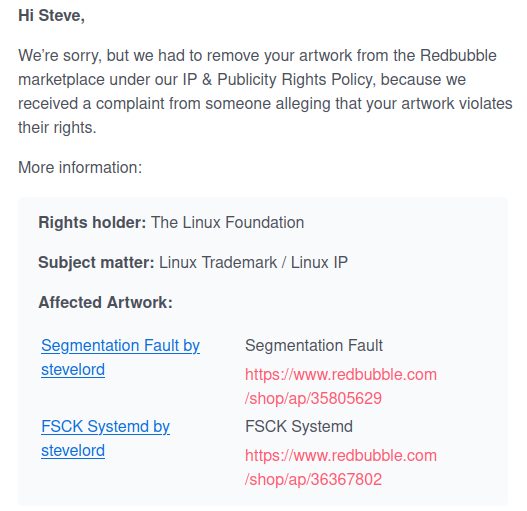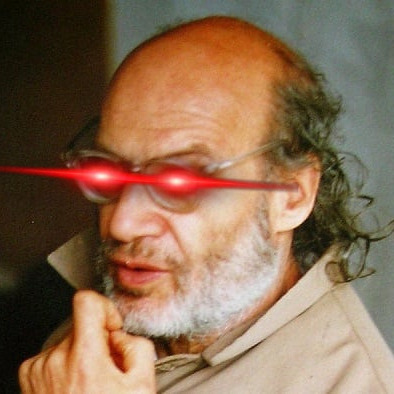It seems that the Linux Foundation has decided that both “systemd” and “segmentation fault” (lol?) are trademarked by them.
Are we certain this complaint was lodged by the Linux Foundation? Frequently DMCA takedowns happen because someone who is not the original rights holder made the complaint. Even when there’s no actual rights being violated. Essentially people taking advantage of automated systems or just people not wanting to deal with possible legal issues, trolling of a different sort.
“Linux” is owned by Linus Torvalds. Can he ask this foundation to change its name ?
Yes, but some funding for Linux (some of which goes directly to Torvalds) comes from the Linux Foundation, so why would he?
Ok but redbubble is fucking infamous for selling merch with blatantly stolen artwork and logos.
They may act on behalf of others.
Well yes, its a storefront where anyone can sell “their” designs for a cut, the thing is, redbubble has basically no process for making sure that’s all happening above board.
I’m talking about the Linux Foundation.
Ok, then how is your comment relevant in reply to mine about redbubble?
The Linuses (Lini?) just can’t stop screwing up this week.
I have rather serious doubts that this is legit. More likely some joker pretending to be from the Linux Foundation sent Redbubble a takedown request.
I agree. Of the 188 marks registered to “The Linux Foundation” with the USPTO, there does not appear to be a mark for “systemd”, “fsck”, or “segmentation fault.” My guess is this is an imposter claim and the artist should counter notice this claim to Redbubble.
FWIW (and assuming the link works) here’s the marks ever registered to the Linux Foundation.
deleted by creator
this has nothing even remotely to do with patents, fam
but it is indeed bullshit.
the purpose of a “trademark” is to prevent the public from being deceived about what they’re purchasing, so you can’t sell “Big Macs” on your own because the public might be deceived into thinking they were purchasing a product from McDonalds, which (I assume) has trademarked the use of “Big Mac” for fast food.
I HIGHLY doubt the Linux Foundation owns the trademark for “Segmentation Fault” with respect to random merch, so… yeah 100% bullshit
(The image does also say “Linux IP” in addition to “Linux Trademark” and I wonder what the hell that is supposed to mean, since “IP” covers a multitude of dissimilar things, maybe it’s just a vague handwavy assertion they make in order to make a takedown without particularly justifying it?)
Funny you should use Big Mac as an example, since McDonalds actually lost that trademark in Europe due to some legal dispute with a pub in Ireland or something
I can understand
Systemdbeing trademarked, but does the Linux Foundation own the trademark for Systemd…? Surely not. I’d think Red Hat before I thought Linux Foundation.

The content isn’t anything to write home about. I don’t really get it.
I’m interested to hear your novel theories about how trademarks and patents are related
They can’t until their patent is granted for it 😂
It’s called the “US Patent and Trademark Office”, so they must be basically the same thing, right‽
That’s stupid. Can they not just focus on whatever their purpose is?
I think the problem is that just like you (and me), they might not know what their purpose is. 😂
Well, good for them that are happy with the segmentation fault (?) Every time I see it I start screaming
again and again: systemd is wrong. lennart poettering and redhat broke the dogma. if you use systemd you should have edge as your main browser.
False equivalence. Edge isn’t FOSS. Systemd is.
Any forks of systemd will have to be renamed to something obviously different from plain “systemd”, but forks already work that way. We are not, for example, using “XFree86” even though the current X Window System is derived from XFree86 code.
Nor must the program files (shell commands, etc) be renamed. OpenSSH still uses the program file name
sshfor compatibility, despite “SSH” being a trademark belonging to someone else.The only dogma systemd has broken is that booting has to be slow, complicated, and unreliable. Good riddance.
The only dogma systemd has broken is that booting has to be slow, complicated, and unreliable.
This was a solved problem before systemd was a thing. And, even if we assumed that Upstart (2006), OpenRC (2007) and others wouldn’t have existed in 2010: How often do you need to reboot your system before the intrusiveness of systemd is worth it?
In Upstart’s readiness protocol, daemons are expected to
SIGSTOPthemselves to signal readiness to the process supervisor. This design is extremely questionable, to put it politely.OpenRC still relies on System V shell scripts, and therefore is not an improvement.
“[T]he intrusiveness of systemd” means nothing to me. I care about what it can do and how well, not whether it’s liked by change-fearing graybeards.
The number of reboots required before the effort to learn systemd becomes worth it is approximately 1. Shell-script-based shutdowns frequently hang, and when they don’t, they take 30+ seconds to shut the system down. Systemd can shut the system down in 5 to 10 seconds. Hallelujah and good riddance to what was one of my least favorite parts of the Linux experience.
systemdhad problems when it was first introduced, but it works much better now and it’s not going away. I would suggest to revisit it again.so arch you say?
“Patent troll” and “required actions to preserve trademarks” are two totally different things. The former is objectively bad in all ways. The second is explainable if there truly is a trademark and said gear infringes on the trademark and may be excusable if the Linux Foundation is forced to act to preserve their branding (trademark law is weird). It’s even more explainable if this is a shitty auto filter some paralegal had to build without any technical review because IP law firms are hot fucking mess. I’m also very curious to see the original graphics which I couldn’t find on Mastodon. If they are completely unrelated and there was an explicit action by someone who knew better, the explanation provides no excuse.
Attacking any company because the trademark process is stupid doesn’t accomplish much more than attacking someone paying taxes for participating in capitalism.
deleted by creator
My comment contains “if” because, speaking from professional expertise, there is a good possibility this is happening because of either a legal agreement I don’t have insight into so I can’t comment on or because of incompetence. It could also be happening from malice which, imo, is the kind of SLAPP bullshit Nintendo is deservedly attacked for. I’m not trying fanboy anything here; I’m just saying we need more information for pitchforks. The Linux Foundation has my implicit assumption of positive intent (unlike, say, Nintendo), so I’m willing to wait and see what happened here before I start attacking The Linux Foundation for something we have a screenshot from Mastodon on.
If you believe my professional opinion is wrong, I would love to learn more about why.
Segmentation fault is the name of the artwork.
The artwork itself might contain the Linux logo
You mean Tux? That’s under a custom attribution license, with no noncommercial clause
Just like champagne only comes from the champagne region of France, true segmentation fault only comes from a linux program shitting itself.
They aren’t satinf they have a trademark on the phrase ‘ segmentation fault’. They are saying the artwork called ‘segmentation fault’ contains a trademarked image/logo/whatever
we don’t know, the post does not elaborate
x86 and x86_64 still have segment registers so it’s not exactly entirely archaic, but they’re not really relevant so that doesnt change what you said. I dont have the exact details on who implemented segmentation first, so I cant elaborate on that.
Aged like fine segmentation fault
—Lucy Liubot
They might not; that is just the title of the art. The art could have other infringing content.
We need to see the actual artwork to know if it has something infringing. This link means little.
Doing a search on the USPTO shows no mark for that combination of words. Did the poster share the design? Because either there’s more to the story on their side or there’s more to the Linux Foundation side. For example, an overworked paralegal with no concept of what terms to include. Alternatively, someone being an asshole with a SLAPP suit. We need more information.
Does the back include Linux logo or smth? Otherwise it makes no sense
You either die a hero, or live long enough to become the villain.


















